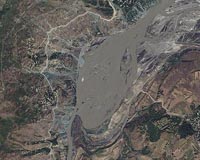| . |  |
. |
Beijing (AFP) Nov 18, 2010 China on Thursday defended its decision to build a dam on the Brahmaputra river in Tibet, amid concerns it could disrupt water supplies downstream in India and harm ecosystems. "In the development of cross-border water resources, China has always had a responsible attitude and places equal emphasis on development and protection," foreign ministry spokesman Hong Lei told reporters. He added China took "full consideration of the potential impact on the downstream area." Chinese authorities officially started construction of the dam in Tibet last Friday, state media reported. The Global Times said it would be the first "mega hydroelectric power plant on the Tibetan plateau," and feature six 85-megawatt power-generating units aimed at curbing power shortages in Tibet. The project is expected to cost nearly 7.9 billion yuan (1.2 billion dollars), it said. But it has stoked concern in India, which worries about the possible impact downstream if the annual flow of water is diverted or reduced. The project has also triggered fears over the environmental impact along the river, which starts high up on the Tibetan plateau and flows east and south in a wide arc before flowing into India, Bangladesh and the Bay of Bengal. "The diversified fauna and flora there have evolved over tens of millions of years and will be damaged," the Global Times report quoted Wang Yongchen, the founder of Beijing-based Green Earth Volunteers, as saying. China's many massive dam projects -- built to meet soaring demand for water and electricity -- have long been a source of controversy. Critics say they often cause huge environmental problems and do little to control floods, while millions of people are displaced to make way for projects that are often riddled with corruption. Earlier this year, Chinese dams were accused of channelling water away from the upper reaches of the Mekong River and contributing to the waterway's record-low levels -- a charge Beijing has dismissed.
earlier related report The $1.2 billion project on the Brahmaputra River will consist of six 85-megawatt generating units, for a total installed capacity of 510 megawatts, with an average annual generating capacity of more than 2.5 billion kilowatt hours. The first unit is to be operational in 2014. China's state news agency Xinhua reported Wednesday that the formal start of construction had begun last Friday. The world's highest river, the Brahmaputra River originates in China's Qinghai-Tibet Plateau, and flows through Bangladesh, where it is called the Jamuna. China maintains that the hydropower station would be a "run of the river" project, which means that it would generate electricity using the natural flow and elevation drops of the river, with minimal downstream impact. "The river flow will not be stopped during construction," said Li Chaoyi, chief engineer of the China Huaneng Group, the prime contractor for the project, Xinhua reports. "After it becomes operational, the water will flow downstream through water turbines and sluices, thereby not affecting the downstream water levels," he said. But if China were to divert or significantly reduce the annual flow of waters into the Brahmaputra, critics say, it could have far-reaching consequences on Indian lands downstream, with millions of Indian farmers adversely affected as less water becomes available for irrigation. Also, the region where the dam is being built is prone to earthquakes and landslides. "The diversified fauna and flora there have evolved over tens of millions of years and will be damaged. Blocking the river may also overturn the balance of the region's ecosystem," Wang Yongchen of Beijing's Green Earth Volunteers, told the Global Times, adding "it seems to be unworthy to build a dam while sacrificing the environment." The Chinese government has touted the $1.2 billion project as a landmark hydropower generation scheme that would boost Tibet's development, providing it with an upgraded power capacity. But Tashi Tsering, a Tibetan scholar of environmental policy at the University of British Columbia, has questioned Beijing's motives for such a project. "The current push to provide Tibetans with electrical power seems primarily motivated by the need for larger hydropower projects to power resource extraction, infrastructure development and ultimately for supply to coastal Chinese cities where demands are the highest," he said in a report on his Web site in May.
Share This Article With Planet Earth
Related Links Water News - Science, Technology and Politics
 Uzbekistan warns of 'disaster' over Tajik plant
Uzbekistan warns of 'disaster' over Tajik plantTashkent (AFP) Nov 17, 2010 Uzbekistan Wednesday warned world powers of a looming environmental disaster from Tajikistan's plan to build a huge hydro-electric dam, in a new show of tensions from the ex-Soviet neighbours. Tashkent also accused Tajikistan's main aluminium plant, the largest in Central Asia and located near Uzbekistan's southern border, of causing increased fluorine-related diseases among the population a ... read more |
|
| The content herein, unless otherwise known to be public domain, are Copyright 1995-2010 - SpaceDaily. AFP and UPI Wire Stories are copyright Agence France-Presse and United Press International. ESA Portal Reports are copyright European Space Agency. All NASA sourced material is public domain. Additional copyrights may apply in whole or part to other bona fide parties. Advertising does not imply endorsement,agreement or approval of any opinions, statements or information provided by SpaceDaily on any Web page published or hosted by SpaceDaily. Privacy Statement |